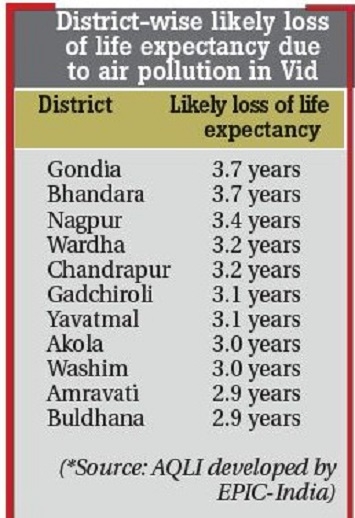Beware! Air pollution is affecting life expectancy in Vidarbha
| Date :26-Nov-2019 |

Staff Reporter :
Ignorance costs, and so does negligence. In case of Vidarbha, ignorance of people about the adverse impact of air pollution on their lives, and negligence of authorities concerned towards deteriorating air quality, may have costs in terms of life expectancy. As per the Air Quality Life Index (AQLI) database developed by University of Chicago, air pollution is likely to affect the life expectancy in Vidarbha districts from 2.9 years to 3.7 years.

As per the data, the districts of Amravati and Buldhana districts show the least adverse impact of air pollution on life expectancy of people, that is, 2.9 years. However, in case of the other nine districts of the region, life expectancy is likely to get adversely affected by a minimum of three years. The data reflects number of years (life expectancy) an average citizen loses in Vidarbha region due to air pollution. Detailed numbers are available on the AQLI website developed by the University of Chicago. Gondia, Bhandara, Nagpur, Chandrapur, Wardha, Gadchiroli, and Yavatmal have some of the worst numbers of loss of life expectancy due to air pollution.
According to experts, the projected loss of life expectancy reflects that Vidarbha’s air quality is ‘slowly but surely’ going the North Indian plains way. Energy Policy Institute-University of Chicago (EPIC) India had released a report on the Indo-Gangetic (also referred to as North Indian plains) and observed that life expectancy ‘is being shortened drastically due to fall in air quality’. AQLI translates particulate pollution concentrations into the impact on lifespans. As far as Nagpur is concerned, if Nagpur meets national standards for air quality (40 µg/m3), life expectancy may increase by 0.8 years. If it meets WHO standards (10 µg/m3), life expectancy of Nagpurians may increase by 3.9 years. However, at present, the loss of life expectancy is pegged at 3.4 years.
Michael Greenstone, the Milton Friedman Distinguished Service Professor in Economics and Director of EPIC, told ‘The Hitavada’ more about the concept of AQLI through e-mail. “Around the world today, people are breathing air that represents a serious risk to their health. But the way this risk is communicated, is very often opaque and confusing, translating air pollution concentrations into colors like red, brown, orange, and green. What those colors mean for people’s well-being has always been unclear. My colleagues and I developed the AQLI, where the ‘L’ stands for ‘life,’ to address these shortcomings. It takes particulate air pollution concentrations and converts them into perhaps the most important metric that exists—life expectancy,” he stated in the e-mail.
AQLI provides a reliable measure of the potential gain in life expectancy communities could see if their pollution concentrations are brought into compliance with World Health Organisation (WHO), national, or some other standard. As far as national scenario is concerned, AQLI points out that if India is successful in reducing air pollution to comply with the WHO’s air quality standard, the people in the country could live about four years longer on an average. If India reduces air pollution to comply with own national standards, people could live more than one year longer on an average. Particulate Matter (PM) pollution is widely believed to be the ‘deadliest form of air pollution’. PM2.5 is a term that refers to particulate matter in the atmosphere, with a diameter of less than 2.5 micrometers, which is the diameter that is about 3 per cent of the diameter of a human hair. In Nagpur and Vidarbha, due to construction activities, increase in vehicle density, and emissions mainly from coal-fired power generation plants are said to be reasons behind high concentration of particulate matter in the atmosphere.
